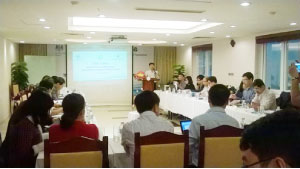A representative from PanNature suggested clearly defining the non-profit status of science and technology organizations to facilitate research, technology transfer, and application. This clarity would also enhance international collaboration and attract funding.

Biodiversity mainstreamed in environmental assessment
A workshop by the People and Nature Reconciliation (PanNature) in Hanoi on March 24 attracted nearly 60 representatives from the Vietnam Environment Administration, Vietnam Administration of Forestry and several national parks and non-governmental organizations. The theme of the meeting was mainstreaming biodiversity criteria in environmental impact assessments in Vietnam.
 Vietnam is recognized as one of the 10 richest biodiversity centers in the world, with diverse forest, marine and wetland ecosystems, an abundance and richness of species and genetic resources and the availability of ecosystem services and local knowledge of management and use of natural resources. This high level of biodiversity is also considered a source of “natural capital” for many regions and countries to reduce poverty and grow towards sustainable development in the context of climate change and food security concerns.
Vietnam is recognized as one of the 10 richest biodiversity centers in the world, with diverse forest, marine and wetland ecosystems, an abundance and richness of species and genetic resources and the availability of ecosystem services and local knowledge of management and use of natural resources. This high level of biodiversity is also considered a source of “natural capital” for many regions and countries to reduce poverty and grow towards sustainable development in the context of climate change and food security concerns.
Vietnam has already set up a biodiversity management system to monitor a network of more than 160 natural conservation areas, passed the Biodiversity Law 2008 and many related policies and provisions. However, Vietnam’s biodiversity is declining becoming increasingly degraded under the pressure of population growth, overexploitation of biodiversity resources and the choice of economic development priorities in recent decades.
Many forests and wetlands have been converted to industrial plantations or used for large-scale infrastructure construction and natural flows of the rivers have been blocked to build hydropower plants without taking into account the impact on biodiversity combined with poor environmental impact assessments and development project decisions.
According to Le Hoang Lan from the Vietnam Association for Conservation of Nature and Environment, many current environmental impact assessment reports have failed to adequately consider sensitive issues with the environment when choosing project locations, especially without assessment on load capacity onto the environment and characteristics of ecosystems. Most reports just focused on the priority ecosystems, and did not give the assessment of changes to biodiversity due to the impact of the project compared to the changes that may occur naturally.
| After nearly three decades of renovation, Vietnam has recorded remarkable socioeconomic growth rates but has failed to pay due attention to biodiversity related issues which are often mentioned in environmental impact assessment reports. |
There is no technical guidance on assessing the impact on biodiversity for certain types of projects; no systematic data on biodiversity related to project areas and related surroundings. Moreover, types of projects requiring environmental impact assessment reports have not been specified, said Pham Anh Dung, the Deputy Director of Strategic Environmental Assessment Division under the Vietnam Environment Administration.
Participants at the workshop agreed that environmental impact assessment reports and policies to mitigate the adverse impact on biodiversity were important elements for the conservation, development and sustainable use of biodiversity. So, environmental impact assessment content needs to be institutionalized and integrated into regulations on strategic environmental assessment and environmental impact assessment, which are part of the revised Environmental Protection Act 2015.



